翻译材料_第五章_英汉句子对比与翻译
- 格式:doc
- 大小:53.50 KB
- 文档页数:5

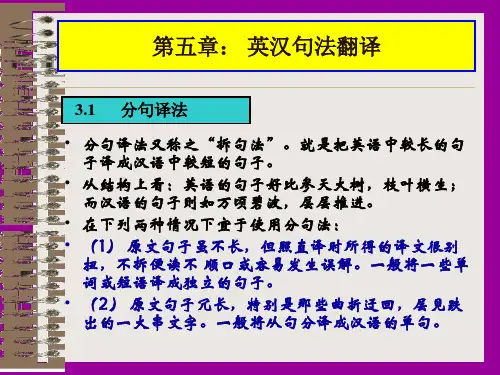

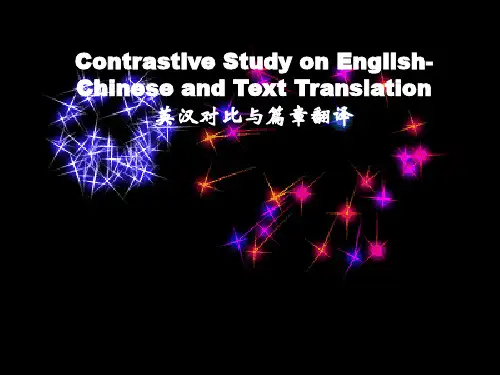


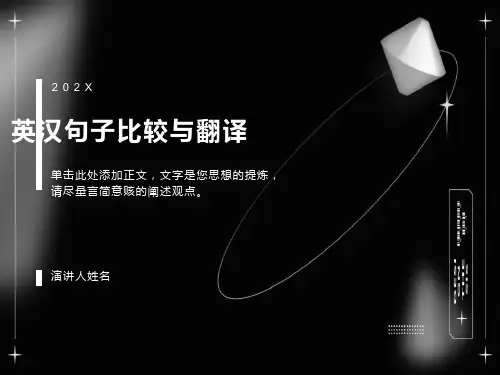
![[英语四六级]Unit 5---英汉对比与篇章翻译](https://uimg.taocdn.com/3990187e3b3567ec102d8af8.webp)
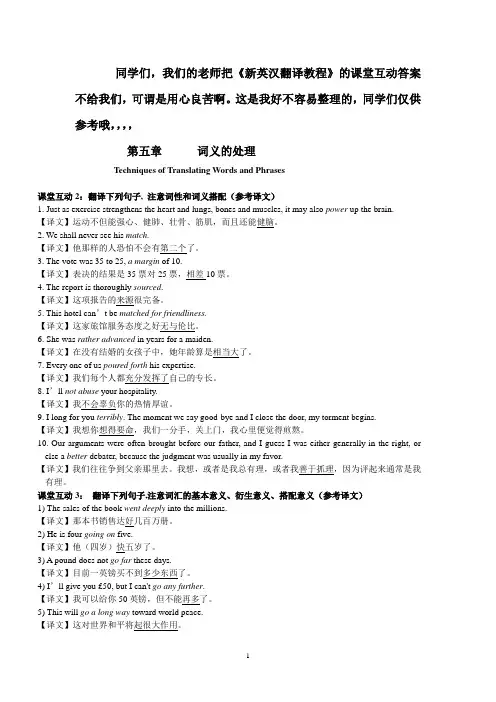
同学们,我们的老师把《新英汉翻译教程》的课堂互动答案不给我们,可谓是用心良苦啊。
这是我好不容易整理的,同学们仅供参考哦,,,,第五章词义的处理T echniques of T ranslating Words and Phrases课堂互动2:翻译下列句子, 注意词性和词义搭配(参考译文)1. Just as exercise strengthens the heart and lungs, bones and muscles, it may also power up the brain.【译文】运动不但能强心、健肺、壮骨、筋肌,而且还能健脑。
2. We shall never see his match.【译文】他那样的人恐怕不会有第二个了。
3. The vote was 35 to 25, a margin of 10.【译文】表决的结果是35票对25票,相差10票。
4. The report is thoroughly sourced.【译文】这项报告的来源很完备。
5. This hotel can’t be matched for friendliness.【译文】这家旅馆服务态度之好无与伦比。
6. She was rather advanced in years for a maiden.【译文】在没有结婚的女孩子中,她年龄算是相当大了。
7. Every one of us poured forth his expertise.【译文】我们每个人都充分发挥了自己的专长。
8. I’ll not abuse your hospitality.【译文】我不会辜负你的热情厚谊。
9. I long for you terribly. The moment we say good-bye and I close the door, my torment begins.【译文】我想你想得要命,我们一分手,关上门,我心里便觉得煎熬。
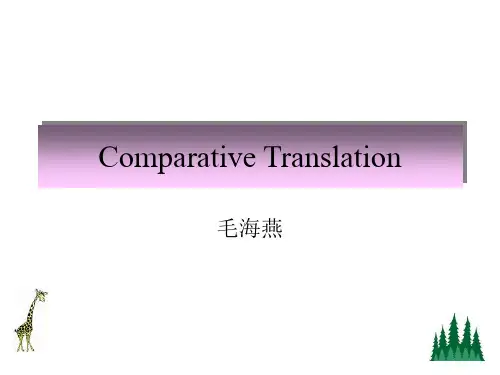

第5单元I 提示同第4单元II 译法要点5.1不妥的合译 5.2 独立结构: with+复合结构5.3 重新梳理句际关系 5.4 误译:被动句5.5漏译 5.6变通:逗号→破折号5.7呼应:主题 5.8变通:增补(现在完成进行时)5.9 误用:介词 5.10误用:词语5.11变通:分译(单词) 5.12误译:语义逻辑5.13变通:阐释法(II) 5.14 风格:对应式换码5.15历史现在时(I)III 原文与译文【原文】香山红叶(II)听着这个白胡子老人絮絮叨叨谈些离奇的传说,你会觉得香山更富有迷人的神话色彩。
我们不会那么煞风景,偏要说不信。
只是一路上山,怎么连一片红叶也看不见?老人说:“你先别急,一上半山亭,什么都看见了。
”我们上了半山亭,朝东一望,真是一片好景,莽莽苍苍的河北大平原就摆在眼前,烟树深处,正藏着我们的北京城。
也妙,本来也算有点气魄的昆明湖,看起来只像一盆清水。
万寿山,佛香阁,不过是些点缀的盆景。
我们都忘了看红叶。
红叶就在高山头坡上,满眼都是,半黄半红的,倒还有意思。
可惜叶子伤了水,红的又不透。
要是红透了,太阳一照,那颜色该有多浓。
我望着红叶,问:“这是什么树?怎么不大像枫叶?”老向导说:“本来不是枫叶嘛。
这叫红树。
”就指着路边的树,说:“你看看,就是那种树。
”路边的红树叶子还没红,所以我们都没注意。
我走过去摘下一片,叶子是圆的,只有叶脉上微微透出点红意。
我不觉叫:“哎呀!还香呢。
”把叶子送到鼻子上闻了一闻,那叶子发出一股轻微的药香。
另一位同伴也嗅了嗅,叫:“哎呀!是香。
怪不得叫香山。
”老向导也慢慢说:“真是香呢。
我怎么做了四十年向导,早先就没闻见过呢?”我的老大爷,我不十分清楚你过去的身世,但是从你脸上密密的纹路里,猜得出你是个久经风霜的人。
你的心过去是苦的,你怎么能闻到红叶的香味?我也不十分清楚你今天的生活,可是你看,这么大年纪的一位老人,爬起山来不急,也不喘,好像不快,我们可总是落在后边,跟不上。
英汉句法结构对比与翻译
1.主谓结构:英语中主语和谓语动词之间的位置固定,而且一般不允许有其他成分插入;汉语中则允许主谓之间插入状语、宾语等成分,主语通常出现在句首,谓语动词出现在句尾。
英语:He is reading a book.
汉语:他正在看书。
2.宾语结构:英语中宾语通常出现在动词后面,而且一般不允许有其他成分插入;汉语中宾语可以放在动词前面或后面,并且可以有其他成分插入。
英语:She likes to eat apples.
汉语:她喜欢吃苹果。
3.状语结构:英语中状语通常出现在动词后面,表示时间、地点、方式等信息;汉语中状语的位置比较灵活,可以出现在句首、句中或句尾。
英语:He goes to school by bus every day.
汉语:他每天坐公交车去学校。
在进行翻译时,需要根据英语和汉语的句子结构差异进行相应的调整和转换。
具体翻译方法有:
1.主谓结构的翻译:将英语的主语翻译为汉语的主语,谓语动词翻译为汉语的谓语动词。
2.宾语结构的翻译:将英语中的宾语翻译为汉语中的宾语,并根据需要放置在动词前面或后面。
3.状语结构的翻译:将英语中的状语翻译为汉语中的状语,并根据需要放置在句首、句中或句尾。
需要注意的是,不仅要考虑句子结构的差异,还要考虑语言的习惯表达方式和上下文的语境。
对于复杂的句子结构和长篇文章的翻译,还需要进行更加细致的分析和翻译。
第五章英汉句子对比与翻译第一节英汉在连贯方式上的“形合”与“意合”连贯是句子依据合理的语义和逻辑关系,恰当地连为一体的语篇特征,但在重意合的汉语中,这种特征往往隐含在上下文中,呈“隐性”状态,但这并不妨碍汉语读者对其阅读和理解,因为汉语是依靠语篇的语境意义来弥补其在逻辑和连贯方面的不足,而英语语篇中的逻辑和连贯关系则表现出“显性”的特征,既它的逻辑和连贯关系是通过外在的形式,既词法和句法结构来体现的,因此,在翻译过程中,译者就应该注意这种“隐性”和“显性”之间的转换。
翻译练习:1)We crossed the Y angtze and arrived at the station, where I bought a ticket while he saw to myluggage… At the sight of his back tears started to my eyes, but I wiped them hastily so that neither he nor anyone else might see them.2)As the weather was getting better, we decided to go for an outing the next day.3)Three month later, when he had spent all his five dollars, he felt obliged to climb onto slow-goingfreight trains, despite the police’s pursuits or arrests.4)It was only his legendary travel experiences, especially the experiences of his visit to the northern partof Shaanxi Province 60 years ago that determined his lifetime cause, thus closely connoting his life with the Chinese revolution.第二节英汉在语义层次表达上的“形合”和“意合”进行英汉对比研究的学者们常将英语句子比作树木结构,将汉语的句子比作竹子结构。
这就是说,英语句子中充满了从属结构,从属结构包括了动词的非限定形式、介词短语和各种分句。
从属结构可以比作“枝杈”;汉语句子充满了并立结构,并立分句之间用逗号分开,直直的,每有“枝杈”,像根竹子。
汉语的这些并立分句常被称作“流水句”。
英语句子的树木结构是英语的形合在语意层次表现上的具体体现:句子的主干(主句)用来表示主要信息,从属结构(枝杈)表示次要信息。
这样意义层次在表面结构上就表现出来了,呈显性;汉语句子的竹子结构是汉语的意合在语意层次表现上的具体体现:句子中充满了在形式上并立的分句,语意层次要靠上下文来表示,在表面形式上看不出来,呈隐性。
英汉翻译中就应该充分考虑到英文和中文的这些不同特征。
翻译练习:1)X-rays are able to pass through objects and thus make visible details that are otherwise impossible toobserve.2)“How does the human brain work” remains one of the most profound questions confronting modernscience.3)One out of every ten persons in 1978 United States labor force was a teenager, compared with one outof fifteen in 1960.4)Situated at the foot of the hill is a hut where I think you will surely find the book that you have beenlooking for in the past.第三节英译汉句型的转换英汉两种语言在表达方式上有相似之处,但更多的是差异。
同一个思想和概念,英语有英语的表达方式,汉语有汉语的表达方式。
在很多情况下,翻译的本质,实际上是一种“替代”。
在英译汉时,需用汉语的表达方式去“替代”英语的表达方式;这中翻译中的句型转换,也可以说是“改换说法”。
翻译练习:1)Wet paint!2)No Smoking!3)No littering!4)Where love is the case, the doctor is an ass.5)Nowadays it is not seldom that a man lives to be seventy years old.6)It is popular for the fine views from the summit of the mountain.7)Man did not learn to write until about 3000 B.C..8)The battle field became something holy. It was not touched.9)For most people the word “education”means “school”and “school”conjures up an image of abuilding with classrooms.第四节英汉句子结构的差异与翻译是“重写”或“改写”英语句子的特点是句子中的每一个成分,均可有修饰语,而且修饰语可以不止一个,每个修饰语都可以很长;一个修饰语还可以被另一个休息语修饰,因此句子结构复杂,犹如“参天大树,枝叶横生”,被称为“树状形结构”。
汉语修饰语少而短,句子由一个一个的分句构成,逐步展开,犹如“万顷碧波,层层推进”,被称为“波浪形结构”。
汉语的这种句式,语法学家称之为“流水句”。
如果说,汉英两种语言在句子结构上有许多差异的话,这是最根本的一个差异。
英汉对译成功的关键就是改换句型。
Nida 曾说过:“In order to translate meaning, form must be changed”。
钱中书先生说:“得意忘言”。
这里所谓的“form”和“言”,主要是指语言形式,既“表达方式”。
就句子而言,主要是指句子结构。
因此,英译汉时,我们要把英语句子的“树状形结构”转换成汉语句子的“波浪形结构”。
翻译练习:1)A beautifully situated park on the lake’s shore provides a perfect spot to savor an ice cream whilewatching the boats darting about on the bay or the exciting arrival of the famous M/S Mount Washington(华盛顿山号游轮)as she docks nearby.2)Of the more than 300 separate tribes, the largest is the Navaho in the Southwest.3)The air seemed almost sticky from the scent of bursting buds.4)Hangzhou’s West Lake is like a mirror, embellished all around with green hills and deep caves ofenchanting beauty.第五节翻译是“重写”或“改写”翻译是“重写”也可以说是“改写”,是学习翻译的一个十分重要的概念。
思果先生在《翻译新究》中说:“我一向认为翻译是翻译,不是写作。
这个观念很害事,可能是学翻译的人走不通的胡同。
翻译不是翻译,是重写。
”“我已经说过,字是桎梏,一定要打破;翻译要意译;要找中文表达原文的意思、感情等等。
不过,我现在还觉得不够;不如说要重写,容易叫读者明白我的用心。
”如果说,翻译中“替代”的方法主要是在翻译词汇和短语的层次上进行的话,句型的转换则主要是在翻译句子的层次上进行的,而重写则更多的是在段落的层次上进行的。
当然,句子翻译中的句型转换,实际上也是重写。
翻译练习:1)Here in New Hampshire there are many opportunities to find a peaceful spot hidden among the lushforests of tall evergreens and hard-woods or next to a rambling brook or pictorial lake.2)Lulled by the gentle motion and soothed by the rippling music of the waves, the babies soon fellasleep.3)It is a curious fact, of which I can think of no satisfactory explanation, that enthusiasm for country lifeand love of natural scenery are strongest and most widely diffused precisely in those European countries which have the worst climate and where the search for the picturesque involves the greatest discomfort.4)Some fishing boats were becalmed just in front of us. Their shadows slept, or almost slept, upon thewater, a gentle quivering alone showing that it was not complete sleep, or if sleep, that it was sleep with dreams.第六节英语长句的翻译在英语长句的翻译中,万万不可根据语法成分的对应来决定汉语语序,否则译文常常是佶屈聱牙,不堪卒读。